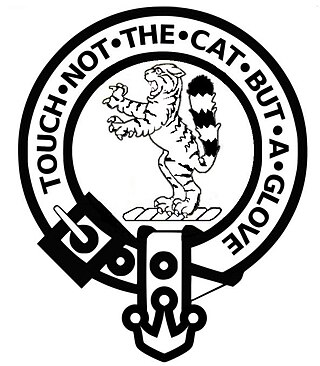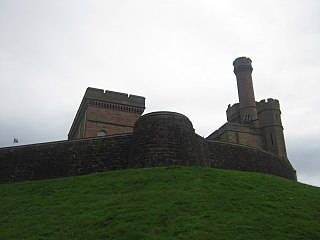Related Research Articles

Clan Chattan is a unique confederation of Highland clans. This distinctive allied community comprised at its greatest extent seventeen separate clans, who each had their own clan chief recognized under Scottish law, but were further united and bound to the superior chief of the Confederation for mutual solidarity, sustenance and protection in the Middle Ages and early modern period in the Great Glen and Cairngorms. A tribal coalition of this magnitude was a source of apprehension to both the Lord of the Isles and the Kings of Scots and records exist of machinations to "crying doon the Clan Chattan" by formenting internal dissension.

Clan Mackintosh is a Scottish clan from Inverness in the Scottish Highlands. The chiefs of the clan are the Mackintoshes of Mackintosh. Another branch of the clan, the Mackintoshes of Torcastle, are the chiefs of Clan Chattan, a historic confederation of clans.

Clan Fraser of Lovat is a Highland Scottish clan and the principal branch of Clan Fraser. The Frasers of Lovat are strongly associated with Inverness and the surrounding area since the Clan's founder gained lands there in the 13th century.

Clan Chisholm is a Highland Scottish clan.

Castle Chanonry of Ross, also known as Seaforth Castle, was located in the town of Fortrose, to the north-east of Inverness, on the peninsula known as the Black Isle, Highland, Scotland. Nothing now remains of the castle. The castle was also known as Canonry or Chanonrie of Ross, the former county.
Sir George Munro of Culcairn was a Scottish soldier of the 18th century from Ross-shire, Scotland. He commanded the 3rd Independent Highland Company from 1714 to 1716, fought at the Battle of Glen Shiel in 1719, led the 6th Company in formation of the "Black Watch" in 1725, the 8th Company of Black Watch when it was regimented in 1739 and again commanded an Independent Highland Company in 1745–46. He was shot in error in 1746.
Robert Mor Munro, 15th Baron of Foulis, and 18th chief of the Clan Munro was a 16th-century Scottish chief. He was known as Robert Mor on account of his large stature. He was the eldest son of Robert Munro, 14th Baron of Foulis. Although this Robert Munro is traditionally 15th Baron and 18th overall chief of the clan, he is only the 8th Munro chief that can be proved by contemporary evidence.
The Mackintoshes of Borlum were a cadet branch of the Clan Mackintosh, a Scottish clan of the Scottish Highlands. Their most famous member was Brigadier William Mackintosh, Laird of Borlum (1658–1743) usually known as Mackintosh of Borlum who was a leader of the Jacobite rising of 1715.
Bunchrew is a small village in the Highland council area of Scotland. It is around 3 miles (5 km) west of Inverness, close to the south shore of the Beauly Firth on the A862.

Clan Munro is a Highland Scottish clan. Historically the clan was based in Easter Ross in the Scottish Highlands. Traditional origins of the clan give its founder as Donald Munro who came from the north of Ireland and settled in Scotland in the eleventh century, though its true founder may have lived much later. It is also a strong tradition that the Munro chiefs supported Robert the Bruce during the Wars of Scottish Independence. The first proven clan chief on record however is Robert de Munro who died in 1369; his father is mentioned but not named in a number of charters. The clan chiefs originally held land principally at Findon on the Black Isle but exchanged it in 1350 for Estirfowlys. Robert's son Hugh who died in 1425 was the first of the family to be styled "of Foulis", despite which clan genealogies describe him as 9th baron.

The siege of Inverness that took place in November 1715 was part of the Jacobite rising of 1715. The town of Inverness and Inverness Castle were being held by the Clan Mackenzie, led by Sir John Mackenzie of Coul who supported the rebel Jacobite cause. Simon Fraser, 11th Lord Lovat, chief of the Clan Fraser of Lovat besieged them, supported by men of the Clan Rose and Clan Forbes.
The Independent Highland Companies were irregular militia raised from the Scottish clans of the Scottish Highlands by order of the Scottish government between 1603 and 1760 in order to help keep the peace and enforce the law in the Highlands and were recognized as such by the government. The officers of the Independent Highland Companies were commissioned as officers of the British Army but the Independent Companies were not recognized as official regiments of the line of the army. The Independent Highland Companies were the progenitors of the Highland Regiments of the British Army that began when ten Independent Highland Companies were embodied to form the Earl of Crawford's Highland Regiment that was numbered the 43rd Regiment of Foot in 1739.
George Mackay of Skibo was a Scottish lawyer, soldier and politician. He fought for the British Government during the Jacobite rising of 1745 and was later a Member of Parliament.
Before the Acts of Union 1707, the barons of the shire of Inverness elected commissioners to represent them in the unicameral Parliament of Scotland and in the Convention of the Estates.

The siege of Culloden House took place on the night of 15/16 October 1745 and was part of the Jacobite rising of 1745. 200 men of the Jacobite Clan Fraser of Lovat attempted to capture Duncan Forbes, Lord Culloden who was the Lord President of the Court of Session, the most senior legal officer in Scotland.

Baron of Muirton is a title of nobility in the Baronage of Scotland.
Baron of Castlehill is a title of nobility in the Baronage of Scotland in Inverness.
Angus McBean, or as he was otherwise known by his family Æneas McBean was a Scottish minister and Covenanter. He was the last Presbyterian minister deposed under Episcopacy.

Hugh Rose, 15th Baron of Kilravock and Chief of Clan Rose, (1663–1732) was one of the Scottish representatives to the first Parliament of Great Britain as MP for Nairnshire.
References
- Am Baile: highland history and culture (website accessed on 14 June 2010).
- Alexander Macbain, Personal Names and Surnames of the Town of Inverness (Inverness, The Northern Counties Printing and Publishing Co. Ltd, 1895), at pp. 87–88 (1720 to 1895)
- ↑ Highland News web-site (13 August 2012), Row as new Inverness Provost is elected; accessed on 26 September 2012
- 1 2 Highland Council news release (13 August 2012), Election of new Leader and Provost of Inverness Archived 4 September 2012 at the Wayback Machine ; web-site accessed on 26 September 2012
- ↑ The Inverness Courier, 29 June 2007, Globe-trotting Bob aiming to engineer a bright future [ permanent dead link ]; web-site accessed on 11 June 2010
- ↑ Highland Council news release (4 August 2008), New Provost of Inverness appointed Archived 3 November 2009 at the Wayback Machine ; web-site accessed on 11 June 2010
- ↑ Provost and Leader of Inverness and Area re-elected, 19 June 2017, Highland Council web-site (accessed on 3 May 2018)